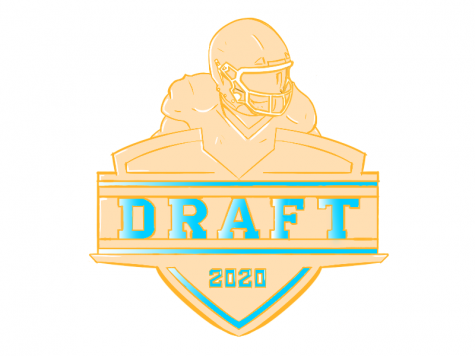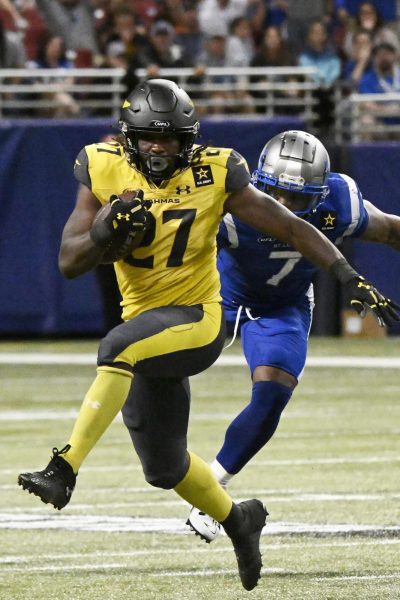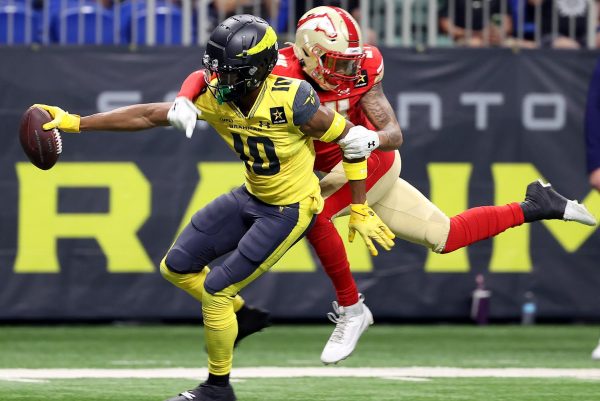NFL Draft First Round Recap: Grades and Analysis of All 32 Selections
April 26, 2020

The 2020 NFL Draft began with its first round on the night of April 23, providing entertainment and a bit of hope at a time when America desperately needs it. With questions about how well a virtual draft event would work, it came as a relief that there appeared to be no major technical glitches. This major technological success aside, what about the players drafted Thursday night? The first round is the make-or-break round in the NFL, a chance to address your team’s biggest need, or an opportunity to pick up elite level talent. So, which teams got it right, and which teams reached?
1. Cincinnati Bengals – Joe Burrow, quarterback — Louisiana State University
Grade: A+
Analysis: Sometimes, the obvious pick is the best pick. Showing a major jump in ability between the 2018 and 2019 seasons, Burrow ascended all the way from a projected late-round pick to first off the board in the draft. Possessing elite accuracy, Burrow led the nation in passing yards, passing touchdowns and completion percentage last season. His movement in the pocket and his awareness when dropping back both characteristics shape what looks to be an elite NFL level talent and have drawn comparisons to Tom Brady’s skills. While Burrow doesn’t walk into as great of a situation as other rookie quarterbacks, he still projects to be an all-pro caliber quarterback at worst, and if Cincinnati is able to assemble a quality team around him, he could lead them to their first Super Bowl title.
2. Washington Redskins – Chase Young, defensive end — The Ohio State University
Grade: A+
Analysis: The Redskins are looking at a complete overhaul under new head coach Ron Rivera, and they managed to select the best pure prospect in the draft. Described as a “generational talent” by some scouts, Young is the latest product of the defensive end factory developing at Ohio State. Following in the footsteps of the Bosa brothers, Young possesses all of the elite physical traits expected of an all-pro defensive end. His elite speed and initial technique allow him to beat his man consistently off the snap and get to the quarterback. Though not as refined in his technique as the Bosa brothers, Young possesses greater physical tools. If Young works on this part of his game and stays healthy, the Redskins are looking at a perennial all-pro for the next 15 years.
3. Detroit Lions – Jeff Okudah, cornerback — The Ohio State University
Grade: A
Analysis: The Lions were reported to be looking at trading down from this spot, but instead, they decided to stay put and address their biggest need in the draft: a cornerback. Okudah was the consensus top corner in the draft and projects to be a true shutdown corner in the vein of Stephon Gilmore, Jalen Ramsey and fellow former Buckeye Marshon Lattimore. The Lions allowed the most passing yards in the league last year and just traded Pro-Bowl corner Darius Slay to the Philadelphia Eagles, so this was a situation in which need and value fit together perfectly.
4. New York Giants – Andrew Thomas, OT — University of Georgia
Grade: B-
Analysis: The Giants had two directions they could’ve gone with this pick. They could’ve pursued a defensive playmaker along the lines of Isaiah Simmons, or they could’ve taken an offensive tackle to help protect Daniel Jones. They decided to go with the offensive tackle, but their selection of Thomas is a curious one. Among the consensus group of the four best linemen in the draft, Thomas was consistently ranked near the bottom. In an effort to protect Daniel Jones, the Giants drafted the weakest pass protector of the group as well. Thomas possesses elite run blocking ability but will need to improve his pass protection skills in order for this pick to be considered a success.
5. Miami Dolphins – Tua Tagovailoa, quarterback — University of Alabama
Grade: A-
Analysis: The Dolphins spent all of last season playing under the assumption by the national media that they were “tanking for Tua.” In an ironic twist of fate, the Dolphins messed up their tank by winning five games, but Tagovailoa suffered a hip injury and fell to Miami at the number five pick. The Dolphins have officially laid their cards on the table and hitched their rebuild onto the brittle body of Tagovailoa. Truly a make-or-break choice by Miami, Tagovailoa possesses all of the tools that earmark a quarterback for future success in the league, but his injury concerns assign a level of risk to him perhaps never before seen in an elite quarterback prospect.
6. Los Angeles Chargers – Justin Herbert, quarterback — University of Oregon
Grade: B+
Analysis: The Chargers managed to stay put at number six and landed the heir apparent to departed franchise quarterback Phillip Rivers. Herbert surprised many by deciding to stay in college for his senior season at Oregon instead of entering the 2019 draft and having a chance to be the number one pick. Nothing about Herbert’s play disqualified him from consideration for the number one pick this year, but Joe Burrow’s historic season and Tagovailoa’s potential pushed them past Herbert on draft night. Herbert may not project out to have the potential of the first two quarterbacks off the board, but he does project to be a solid starter in the NFL as he possesses high-level arm talent and decent agility outside of the pocket, fitting favorably into the modern-day quarterback position.
7. Carolina Panthers – Derrick Brown, defensive tackle — Auburn University
Grade: B+
Analysis: Carolina had a gaping hole at defensive tackle coming into the draft, so Brown was always viewed as the likely pick here. Brown is viewed as the best run stopper in the draft, and his ability to produce in the biggest games last year at Auburn helped raise his draft stock into the top ten. Brown relies on his power to get into the backfield and will likely need to work on his technique in order to excel at the next level, but in terms of a sheer physical force on the interior defensive line, no other prospect compared to Brown.
8. Arizona Cardinals – Isaiah Simmons, outside linebacker — Clemson University
Grade: A+
Analysis: The best defensive prospect in this draft not named Chase Young, Simmons is a veritable swiss army knife on defense. Able to line up anywhere on the field on defense, Simmons possesses physical talent perfectly suited to playing linebacker in the modern NFL. Clocking in at 4.39 seconds in the 40-yard dash at the combine, Simmons possesses the speed to cover slot receivers and the size needed to match up with the top tight ends in the NFL, notably George Kittle, with whom he’ll match up twice a year now. His high level of adaptability will be a boon for the Cardinals in the NFC West, and they were given an absolute gift of a pick at number eight.
9. Jacksonville Jaguars – C.J. Henderson, cornerback — University of Florida
Grade: B+
Analysis: Comfortably the second-best cornerback prospect in the draft, Henderson addresses the biggest positional need for the Jaguars. With the trades of Jalen Ramsey and AJ Bouye, the Jaguars needed to reload at the position, and they picked up a solid corner in Henderson. Regarded more for his coverage ability than his run support, Henderson will need to improve on this part of his game in order to fill the shoes left empty in Jacksonville.
10. Cleveland Browns – Jedrick Willis, offensive tackle — University of Alabama
Grade: A-
Analysis: Baker Mayfield is out of excuses. With the additions of OT Jack Conklin and new head coach Kevin Stefanski followed by the selection of Willis, Mayfield will be well protected next season. It will need to be determined where on the line Willis will play, but he was the number two offensive tackle on my board for good reason. Possessing excellent size and technique for his position, Willis should be right at home wherever the Browns decide to play him next season.
11. New York Jets – Mekhi Becton, offensive tackle — University of Louisville
Grade: C+
Analysis: The Jets had a choice to either address the wide receiver group to help Sam Darnold with more weapons or the offensive line to keep Darnold on his feet. They chose to address the offensive line. Becton is an athletic marvel, managing to run a 5.10 40-yard dash time at 364 pounds. There are some concerns about his weight, and his technique could use some polishing in order for him to become the stalwart on the offensive line that Darnold needs. Off the back of addressing the line in free agency, there was a need for the Jets at wide receiver, and they could have stood to benefit greatly from selecting a receiver at this spot.
12. Las Vegas Raiders – Henry Ruggs III, wide receiver — University of Alabama
Grade: B-
Analysis: The Raiders decided to begin their tenure in Vegas with a draft pick that harkened back to the days of Al Davis with the selection of Ruggs. A true burner through and through, Ruggs possesses elite-level speed and will serve as the Raiders’ counterpoint to Tyreek Hill in the AFC West. A scoring threat every time he touched the ball, Ruggs scored on nearly 25% of his receptions, an absolutely unheard of conversion rate. Ruggs is not nearly as polished a receiver in terms of technical skills as some of the other prospects in this draft and will need to improve in those areas in order to justify his status as the first receiver off the board.
13. Tampa Bay Buccaneers via San Francisco 49ers – Tristan Wirfs, offensive tackle — University of Iowa
Grade: A
Analysis: A curious move, perhaps only motivated by the knowledge that another team was trying to trade up into this pick. The Buccaneers gave up a fourth-round selection to the 49ers to move up one spot to take Wirfs. Wirfs was projected by some as the best offensive lineman in the draft, and it was surprising to see him slip and be available at 13. Tampa gets a complete prospect at tackle, and he figures to slot into a starting role right away to help keep Tom Brady off the ground.
14. San Francisco 49ers via Tampa Bay Buccaneers – Javon Kinlaw, defensive tackle — University of South Carolina
Grade: B
Analysis: The 49ers first acquired the 13th pick from the Colts in exchange for defensive tackle Deforest Bucker, and after trading down to 14, they ended up drafting his replacement. Kinlaw was a solid player on the line for the Gamecocks during his college career, though at times he battled bouts of inconsistency, and he’ll be asked to help continue one of the great strengths of the 49ers. This was very much a luxury pick for San Francisco, and it’s fair to wonder if drafting a wide receiver would’ve benefitted them more.
15. Denver Broncos – Jerry Jeudy, wide receiver — University of Alabama
Grade: A
Analysis: As expected, Alabama saw two receivers drafted in the first round Thursday night but not in the order many expected. Jeudy operated as the number one receiver last season for Alabama and flashed fantastic technical route running ability and top-end speed, albeit not as fast as teammate Henry Ruggs III. Jeudy will look to partner with breakout receiver Courtland Sutton in Denver, as John Elway gifted his second-year quarterback Drew Lock another weapon to look to on the outside.
16. Atlanta Falcons – A.J. Terrel, cornerback — Clemson University
Grade: B-
Analysis: Terrel fills an immediate need for the Falcons, who needed to replace starting corner Desmond Trufant who was released by the team in the offseason. Terrel clocked in a 4.42 40-yard dash time, and his height of 6’1” makes him the ideal corner in terms of physical attributes to go against the top receivers in the NFC South. However, at times, Terrel has a tendency to be burned by the big play, as evidenced in the National Title Game when LSU repeatedly exposed him downfield on a number of plays. He will need to fix this issue to excel at the next level.
17. Dallas Cowboys – CeeDee Lamb, wide receiver — University of Oklahoma
Grade: A-
Analysis: Truly a luxury pick for the Cowboys. Rather than addressing a defense filled with holes, Jerry Jones, drafting from the comfort and privacy of his $250 million dollar yacht, made the move to take one of the best players available on the board and went with Lamb. Lamb has the highest ceiling of all the wide receiver prospects in the draft and has earned comparisons to Cardinals wide receiver DeAndre Hopkins with his excellent ability to high point the football and make the contested catch. He possesses explosive speed and will likely line up out of the slot to start his career in Dallas.
18. Miami Dolphins – Austin Jackson, offensive tackle — University of Southern California
Grade: B-
Analysis: The Dolphins gave up the most sacks in the NFL last season, and with the decision to draft Tagovailoa, this was an area they needed to improve in to help protect their quarterback. Jackson possesses good physical ability, but there are questions if he’ll be able to start right away in the NFL. With Tagovailoa potentially sitting his first year in Miami, this was a draft selection made with the future in mind rather than Jackson’s ability to contribute immediately.
19. Las Vegas Raiders – Damon Arnette, cornerback — The Ohio State University
Grade: D
Analysis: An absolute reach of a pick, Arnette was evaluated by most scouts around a third-round pick, and the Raiders drafted him at 19. Arnette lacks technique and needs vast refinement in order to excel in the NFL. The Raiders needed a corner but displayed major impatience, and for the second year in a row, the Raiders made a truly head-scratching defensive selection in the first round.
20. Jacksonville Jaguars – K’Lavon Chaisson, outside linebacker — Louisiana State University
Grade: B+
Analysis: The Jaguars are in full rebuild mode on defense, and Chaisson will help them immediately out of the box. Pairing with second-year player Josh Allen, Chaisson will provide excellent pass-rushing ability on the other end of the line. The one major concern with Chaisson is his health, as he suffered a torn ACL in 2018 and missed some time in 2019 with an ankle injury.
21. Philadelphia Eagles – Jalen Reagor, wide receiver — Texas Christian University
Grade: B-
Analysis: This was a position group the Eagles absolutely had to address in the draft, but the big question will be if they selected the right receiver. Reagor saw a dip in production last season behind unstable quarterback play at TCU, but he provides big playability for an offense that was sorely lacking last season after the injury to DeSean Jackson. It seemed to be a little bit of a head scratcher of a pick with Justin Jefferson out of LSU still on the board at the time of this pick, Reagor will need to produce right out of the gate to justify his selection.
22. Minnesota Vikings – Justin Jefferson, wide receiver — Louisiana State University
Grade: A-
Analysis: The national leader in receptions last year at LSU in a team of superb wide receivers, Jefferson emerged as the clear number 1 option for Joe Burrow last season. An absolute wizard coming out of the slot, Jefferson will replace Stefon Diggs in Minnesota and might see his role expand to playing outside the numbers more often than he did at LSU.
23. Los Angeles Chargers via New England Patriots – Kenneth Murray, inside linebacker — University of Oklahoma
Grade: B+
Analysis: As surely as there are death and taxes, the New England Patriots once again traded out of the first round. The Chargers gave up a second- and a third-round pick in order to move up and draft Murrary, and he fit what the Chargers were looking for. Murray flashes an athletic skill set that will serve him well in the NFL. Inside linebacker was one of the areas the Chargers needed to address in this draft, and they made a move to pick up the top prospect in the draft at the position.
24. New Orleans Saints – Cesar Ruiz, center — University of Michigan
Grade: C+
Analysis: Right at this moment, Ruiz has the feel of a prospect that will help down the road, making this pick a very curious one given the Saints’ current position in the NFL. While they could stand to benefit from adding another playmaker on offense, head coach Sean Payton has a history of picking up quality pieces for the offensive line, and it would be hasty to condemn this pick straight away.
25. San Francisco 49ers via Minnesota Vikings – Brandon Aiyuk, wide receiver — Arizona State University
Grade: B
Analysis: The 49ers were in major need of a wide receiver to replace the departed wide receiver Emmanuel Sanders, and they traded up for Aiyuk from Arizona State. Known as a technical operator, Aiyuk should slot smoothly into how Kyle Shanahan likes to use his receivers in San Francisco. The big question with Aiyuk is if he’ll be able to match the production of the other receivers at the top of this draft class. If he’s unable to do so, there will be a lot of second-guessing the 49ers’ decision to pass up CeeDee Lamb and Jerry Jeudy at 14.
26. Green Bay Packers via Miami Dolphins – Jordan Love, quarterback — Utah State University
Grade: Currently: F; For the future: A+
Analysis: The Green Bay Packers pulled off the shocker of the first round, trading a fourth-round selection and the 30th pick for the 26th pick to select Jordan Love. For a team that went 13-3 last season and was believed to be a receiver or two away from the Super Bowl, this did absolutely nothing to help the Packers now. The Green Bay Packers have never drafted a skill-position player in the first round with Aaron Rodgers as the starting quarterback, and when they finally did, it was to draft Rodgers’ replacement. This selection does nothing to help Green Bay at the present, and it will be interesting to observe Rodgers’ reaction to this development. In terms of looking toward the future, this is a great selection for Green Bay. Love is viewed as a raw project quarterback who possesses all of the physical tools needed to succeed as a quarterback in the NFL, but he needs major work in other areas of his game to succeed at this level. His outstanding 2018 was counterpointed by a 2019 season at Utah State where he struggled under the direction of a new coaching staff. In Green Bay, Love walks into a situation in which he will not be thrown to the wolves immediately like Josh Allen. Much like Aaron Rodgers learned under Brett Favre for three seasons, it’s highly likely Love will do the same under Rodgers. Green Bay has been blessed for three decades with Hall of Fame-level talent at the quarterback position, and they hope Jordan Love will be able to continue that spell of good fortune.
27. Seattle Seahawks – Jordyn Brooks, inside linebacker — Texas Tech University
Grade: C
Analysis: In the first round the last few years, the Seahawks have become known for making the prototypical “him?” sort of pick. Brooks fits this trend as a truly odd selection. With LSU’s Patrick Queen still on the board at inside linebacker, the Seahawks chose to go with Brooks out of Texas Tech instead. Brooks is a tackle machine and tallied 108 last season at Texas Tech, but he does come with questions about where exactly he will play at the NFL level.
28. Baltimore Ravens – Patrick Queen, inside linebacker — Louisiana State University
Grade: A-
Analysis: The Ravens addressed their need on the defensive line during free agency and used their first-round selection to fix the last hole on their defense at the inside linebacker position. Queen is slightly undersized for an NFL linebacker, but his athletic ability is a perfect fit for the modern-day position. Linebacker has been a position the Ravens have historically been very successful at drafting, which bodes well for Queen’s chances of NFL success.
29. Tennessee Titans – Isaiah Wilson, offensive tackle — University of Georgia
Grade: B
Analysis: With the departure of Jack Conklin to Cleveland in free agency, this was a position Tennessee had to address in the draft to protect their investment in Ryan Tannehill and continue to stick to their identity as a ground-and-pound team. Wilson suffered from bouts of inconsistency last year, but his measurables and flashes of potential have most NFL scouts hopeful he could develop into a force on the offensive line in the NFL.
30. Miami Dolphins via Green Bay Packers – Noah Igbinoghene, cornerback — Auburn University
Grade: C+
Analysis: The Dolphins made the last of their three first-round selections and ended up going with Igbinoghene out of Auburn. With the signing of former Dallas Cowboy Byron Jones in free agency, cornerback wasn’t a position of need for Miami, making this a luxury pick. Igbinoghene is a former wide receiver converted to cornerback, and at only 20 years old, he will likely require some time to contribute on a consistent basis.
31. Minnesota Vikings via San Francisco 49ers – Jeff Gladney, cornerback — Texas Christian University
Grade: B+
Analysis: The Vikings needed to address the cornerback position early in the draft, and they decided to invest a first-round pick in Gladney. Gladney has the possibility to contribute right away for the Vikings as he possesses strong pass coverage skills evidenced by his 26 pass breakups during his last two seasons of college football led the nation. Despite not measuring in as physically impressive as the corners at the top of the draft, Gladney provided good value for Minnesota to fill a crucial need at the tail end of the first round.
32. Kansas City Chiefs – Clyde Edwards-Helaire, running back — Louisiana State University
Grade: A
Analysis: The Chiefs had the enviable position as Super Bowl champs to not have a dire need at any one position. With one real need at the corner but no prospects appearing worth a selection at that point, the Chiefs instead picked up a luxury in Edwards-Helaire out of LSU. While the Chiefs already possess a number of running backs on the roster, Edwards-Helaire provides a level of utility not present on the roster elsewhere. This pick gives Patrick Mahomes and the Chiefs offense a “do-it-all” weapon out of the backfield in the same vein as Darren Sproles and ensures they will continue to be the most lethal offense in the NFL. While not the top-rated RB on many people’s draft boards, Edwards-Helaire is a perfect fit for what Kansas City likes to do on offense, and if his pass protection is able to improve, he could become an every-down sort of running back for Kansas City.
The first round brought forth plenty of interesting picks, and credit must be given to the NFL, ESPN and the NFL Network for putting on this event as well as they did. While we didn’t get to see people walk across a grand stage, the NFL still did their best to give us a window into the moment these players’ lives were changed forever. Because of that, while some teams came out bigger winners than others, one thing that is safe to say is that, just for one night, all football fans were winners again.









